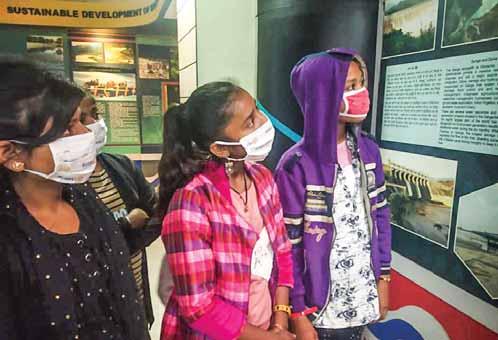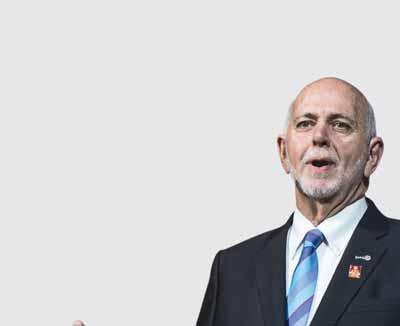
7 minute read
A fun way to learn about River Ganga
To give the slum children of their city an exposure to a slice of Indian culture, members of the Rotary Club of Allahabad Midtown, RID 3120, conceived of a special project — take about 100 of these children, in small batches to the country’s first state-of-the-art Ganga Gallery.
This gallery was inaugurated in 2011 in Prayagraj at the National Academy of Sciences India (NASI). This unique museum houses an interesting range of exhibits that offer the viewer a 360 degree explanation of all aspects of River Ganga. Says Dr Divya Bartaria, president of the club, “Our main aim was to sensitise these children about a wonderful heritage they had inherited, but which, over the years, had been allowed to rot away for so many different reasons, the main one being that we are yet to inculcate pride in our national treasures.”
Advertisement
In a discussion with the club members, the executive secretary, NASI, Dr Neeraj, explained to them that though “the holy Ganga occupies a unique position due to its socio-economic, cultural, scientific and ecological significance, the very existence of this river is under threat due to the
Rasheeda Bhagat

enormously increasing loads of pollutants that are dumped in it year after year.” Hence the council of NASI decided to make the people aware of the need for conservation and restoration of the Ganga by establishing a Ganga gallery, using a scientific approach in order to highlight the religious, cultural, socio-economic and scientific aspects of the river.
Move over to the Rotary club; the members had to find transport to pick up the children from their homes and take them to the Ganga Gallery and then drop them back home. In came a good Samaritan in the form of club member Arun Bagga, who


Children learn about the various facets of River Ganga at the Ganga Gallery.
offered his Maruti cab, aptly titled ‘Blessings’, for the ferrying of these children free of cost. “It was a privilege for me to offer my free cab services


towards this endeavour,” he says. Seeing its success, and the interest and joy of the children, both Divya, he and other club members have decided to continue this project, extending its reach to more children.
As batches of children were taken to this museum, and were explained the need to be conscious of and treasure and cherish their heritage, Priti, a student of Class 12 and living at the Gau Ghat slum, expressed her happiness on two counts; first to get an outing such as this during the pandemic, and secondly, to learn something new about the river that they all had taken for granted. After the visit to the museum, each batch of children was taken to a Rotarian’s house and given a sumptuous lunch, and a return gift too.
Added Bharati, one of the children: “It was really fun being a part of this project. We enjoyed the winter outing and also got an overwhelming experience with Rotarians’ families.” All the children cherished the moment by playing games, exploring nature, having refreshments, sharing experiences, and generally having a good time, added Divya. “And in the process, we all learnt something so valuable too.”
Coordinator and guide at NASI, Meera Shukla, was honest when she said that “although the children were not really capable to grasp all the scientific aspects of this museum, it was good to see that their curiosity has been roused. They were asking questions and trying to understand the various facets about the river, something they had not been exposed to earlier.”
But as with all practical experiences, the children were fascinated with the cultural, religious, economic, socio-scientific and related aspects of the river Ganga that are explained graphically here. As the gallery is equipped with landscapes and sculptures, animated models, multimedia graphics and designs, the myths and legends connected to the origin and voyage of the holy river, it gripped their interest. Keeping in mind social distancing norms, in each trip only 6–7 children, in the age group 8–18 were taken. Started in November, this project has already covered 100 children.



New Rotary models being worked out: Barry Rassin
Rotary will have a robust structure 10 years down the line with 45 regional boards managing its global affairs, while district governors will be playing an advocacy role to motivate clubs for membership growth and engagement, said PRIP Barry Rassin, chairman, Shaping Rotary’s Future Committee. This panel has recommended certain “far-reaching changes to restructure the organisation but we are open to suggestions and inputs to accomplish these changes to sustain growth,” he said.
Addressing the monthly virtual meet hosted by the Synergy Rotary Friendship Alliance jointly with one of its partner clubs, this time with RC Dhulikhel, RID 3292, Rassin said Rotary’s core values will remain the same, “but we will create a structure that will enable us to do even more than what we have done so far in a much better manner.” In the coming years, diversity, equity and inclusion will drive Rotary’s expansion, he noted, and “at the same time there is a growing desire for regionalisation among the 34 zones.” His team is working on an action plan that nurtures leadership qualities among aspiring Rotarians; with each zone having an average membership of 35,000 there is a need to differentiate them on the basis of culture, demography and other unique features without compromising on Rotary values, he explained.

New structure
Rotary clubs at the bottom of the pyramid need a flexible structure that enables them to engage with their members, act on their aspirations and manage retention. The new governance model is being worked out with emphasis on clubs. “At present there is a disconnect between clubs and RI as most of them don’t know our strategic goals and priorities. Long-term changes are being studied for district governors,” Rassin said. In the next six years or so, some of the models will be “plugged in to see how it works across regions, say from Australia to Britain and the US. After measuring their outcomes, we will tweak it further to suit our needs.” Merit and skillsets will be the sole criteria for selecting the members of regional boards, and “they can have their own office, even with paid staff, but without burdening the clubs with additional dues.” In another 10 years time, the members at the RI board and TRF trustees must reflect the diversity and equity that are being envisioned, he said.
Rotaractors bring in a different set of dynamics and enthusiasm to Rotary and “now they are being treated as equals with Rotarians. While Rotaract and Rotary clubs need to work together, it is important that Rotaractors do not lose their identity. Of course with age relaxation, they can join Rotary clubs whenever they feel like doing so.”
TRF Trustee Dean Rohrs from Canada said, “we are just stepping out of an elementary plan which needs to be adjusted with changes based on suggestions and inputs from Rotarians.” With the virtual platforms sweeping the world, Rotary needs to adapt to the emerging new opportunities for growth by creating a new flexible model of governance, she said.
DG Rajiv Pokharel, RID 3292, said clubs must do impactful projects to enhance their public image and induct past Rotaractors in large numbers. His district is doing 103 global grant projects and has got approval for 27 such projects this year. RC Dhulikhel president Sushil Byanju Shreshta welcomed the 250 virtual delegates from Europe and the ASEAN countries. PDGs Keshav Kunwar (Nepal), Gowri Rajan (Sri
Lanka) and Sunil K Zachariah (India) spoke. RAC Kathmandu University of Medical Science president Roshni Prajapati compered the event.

V Muthukumaran







